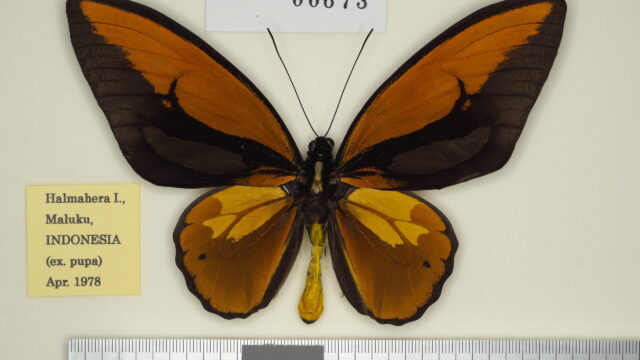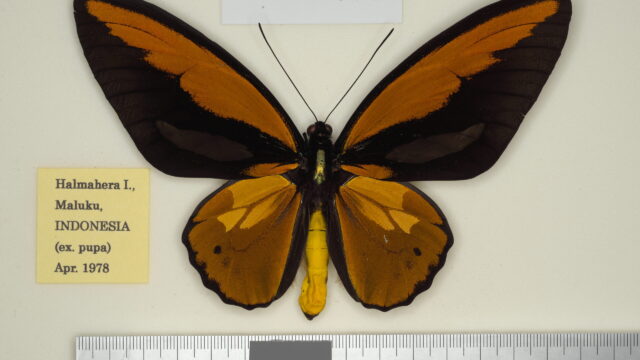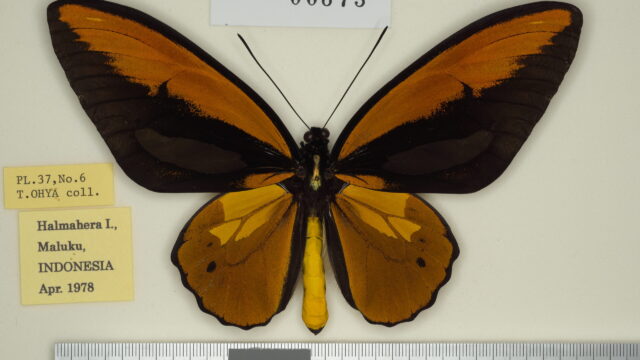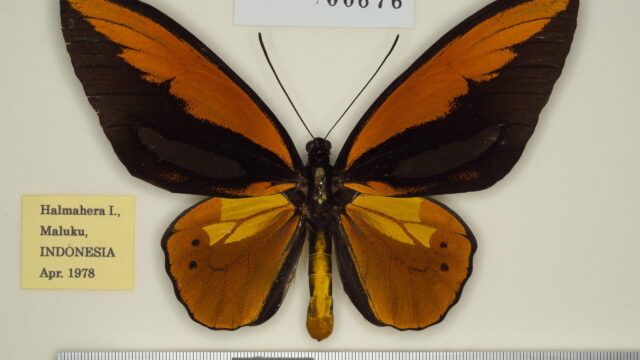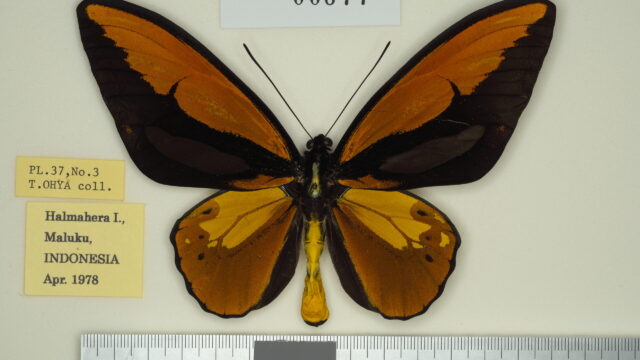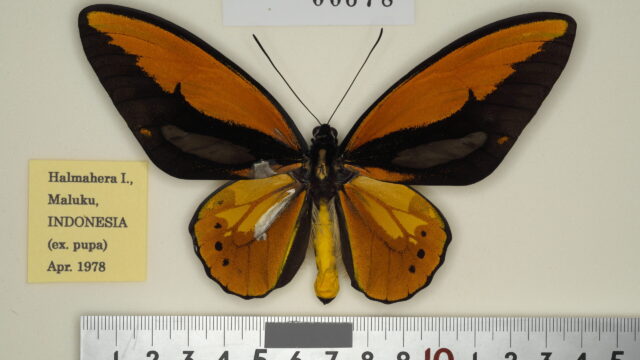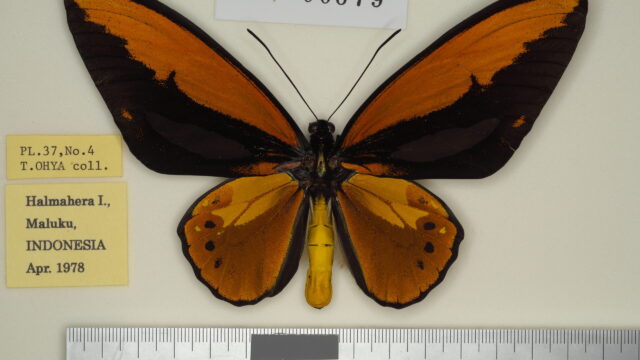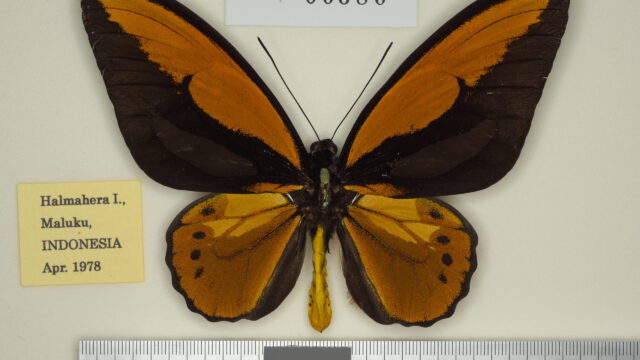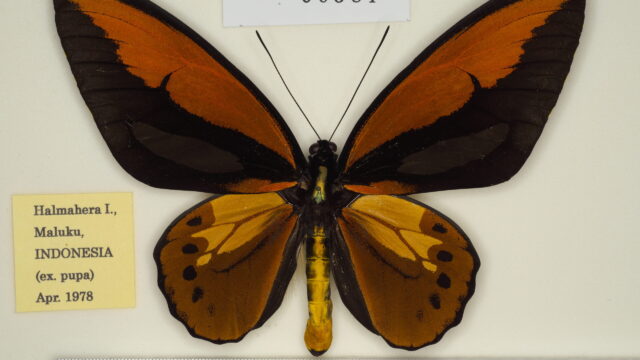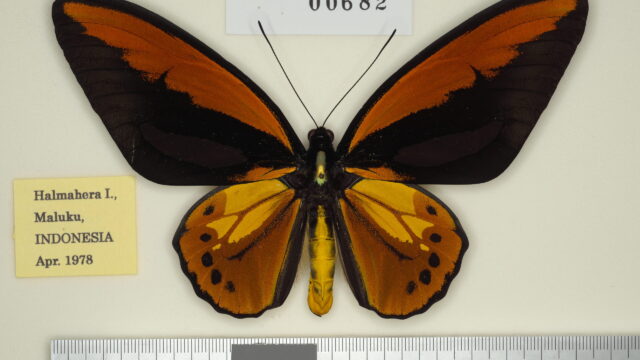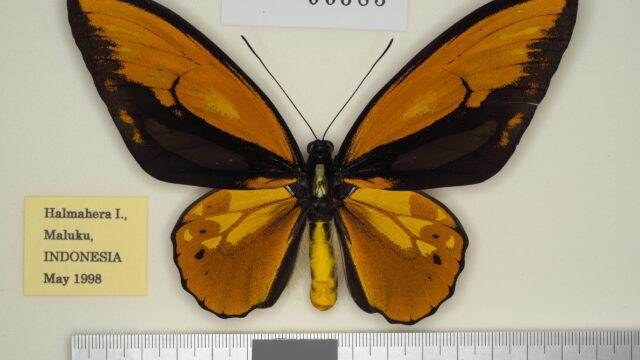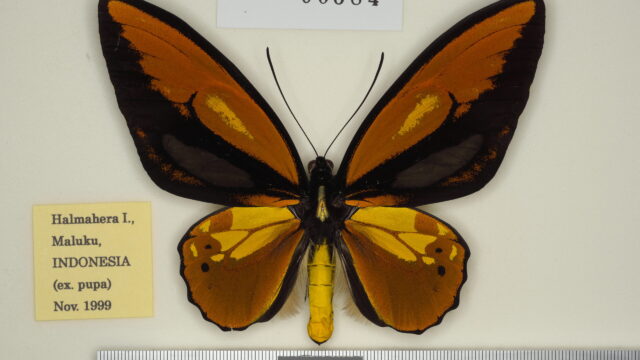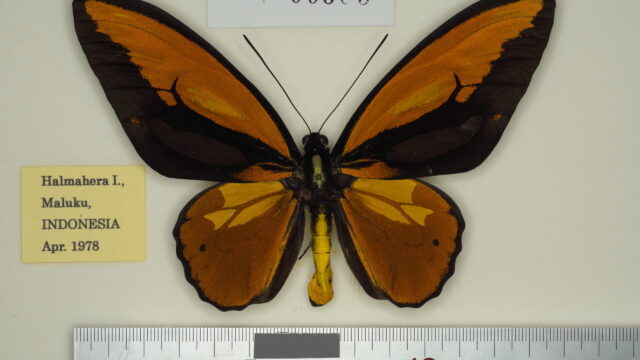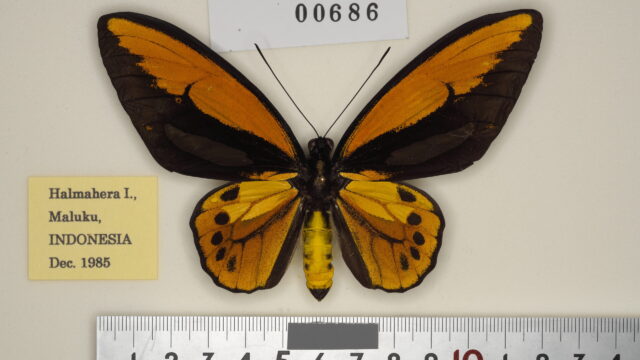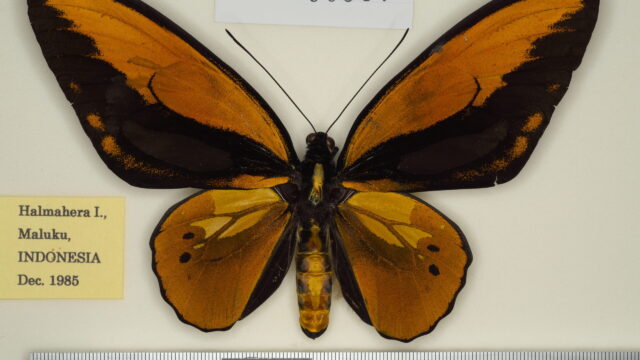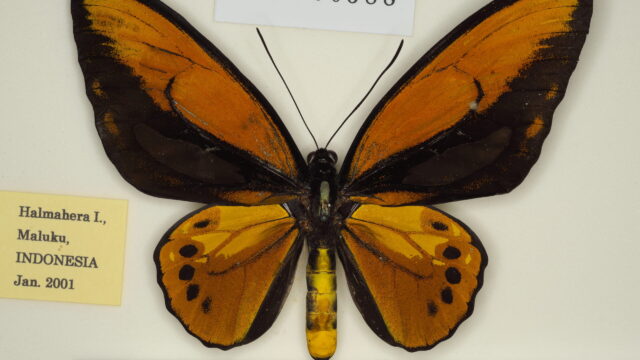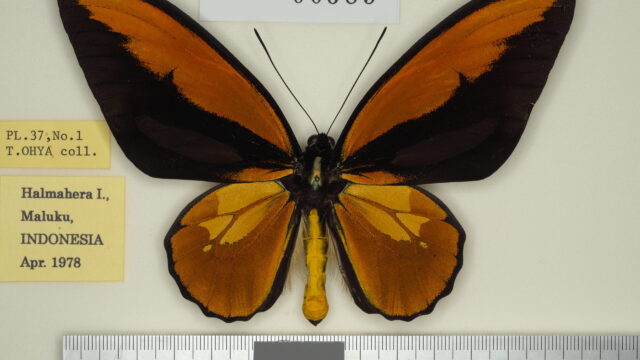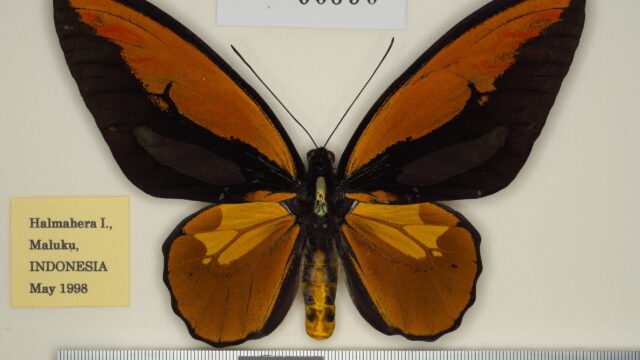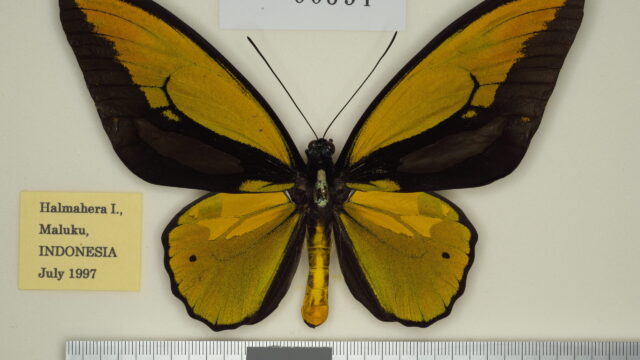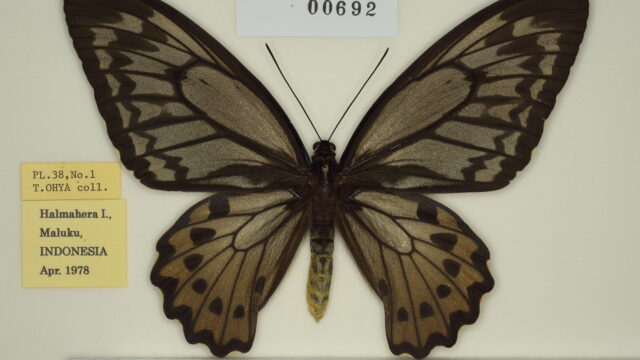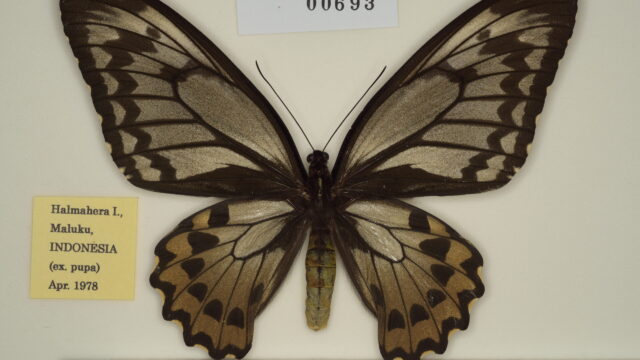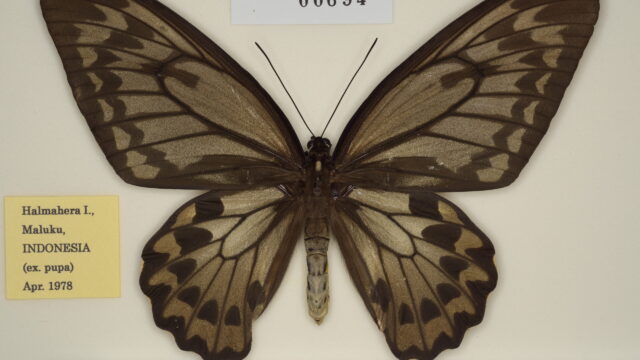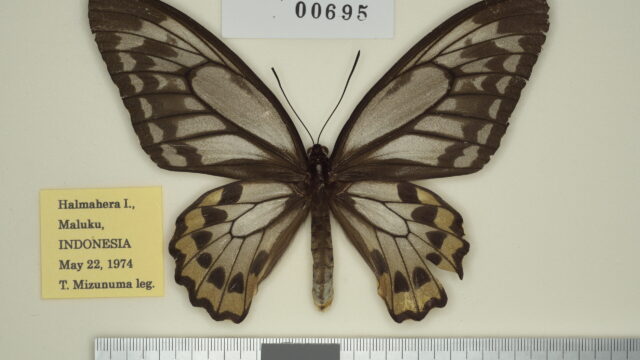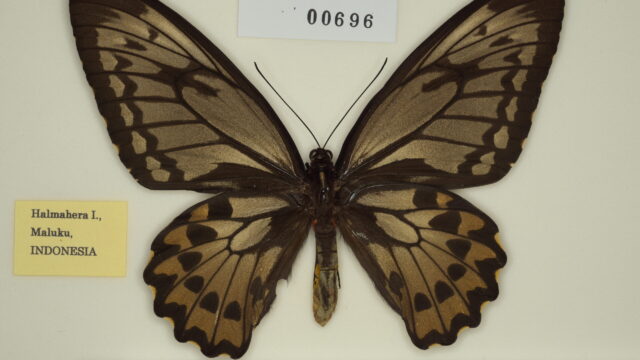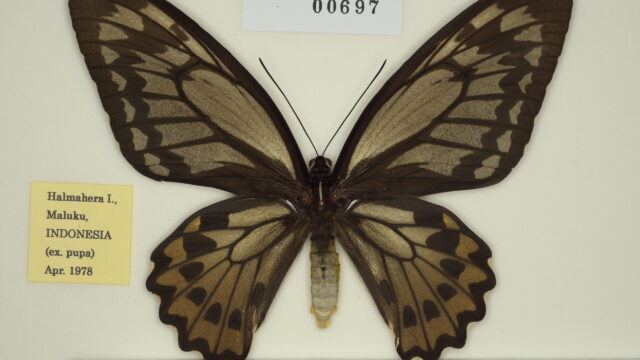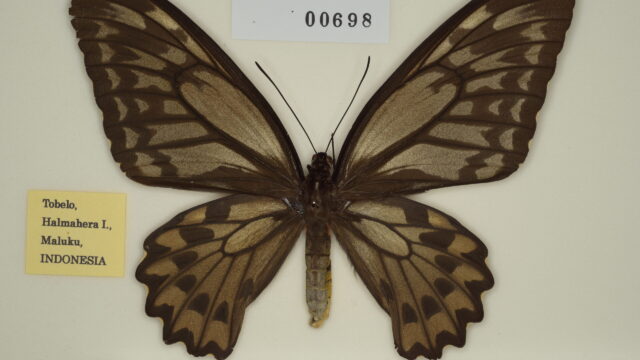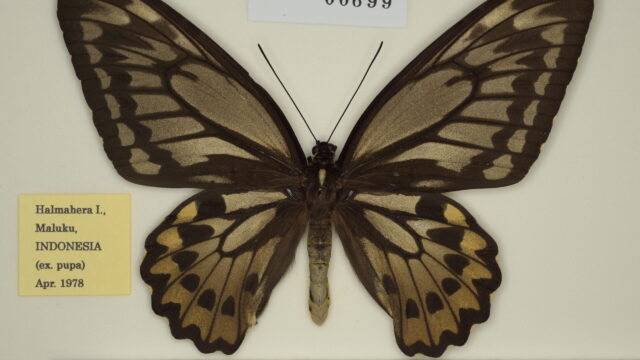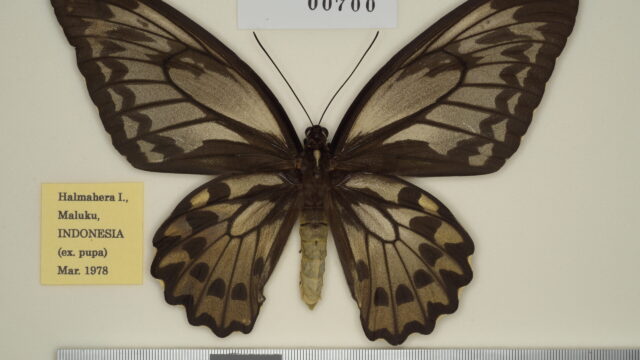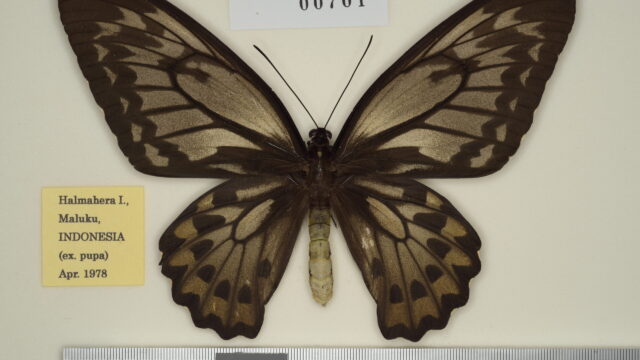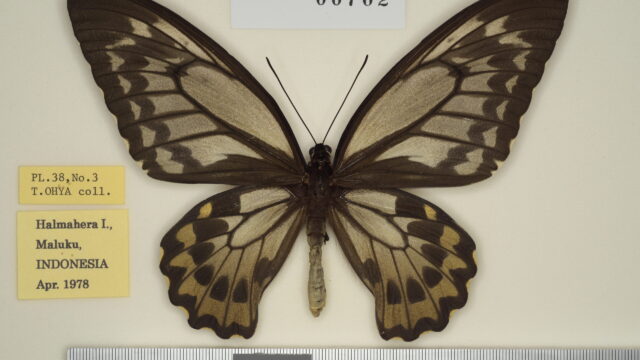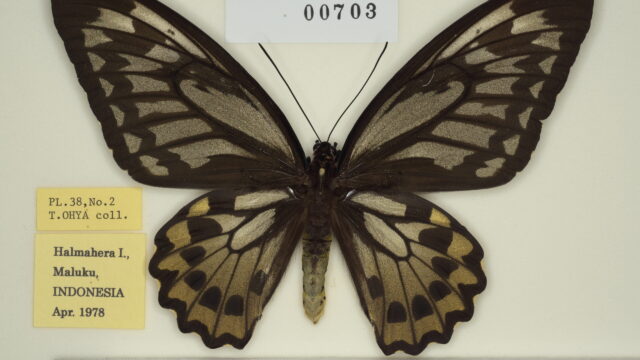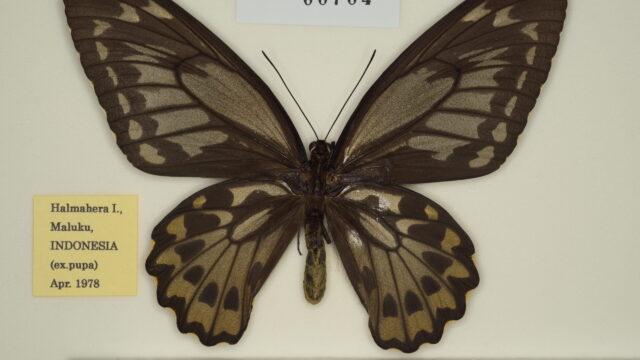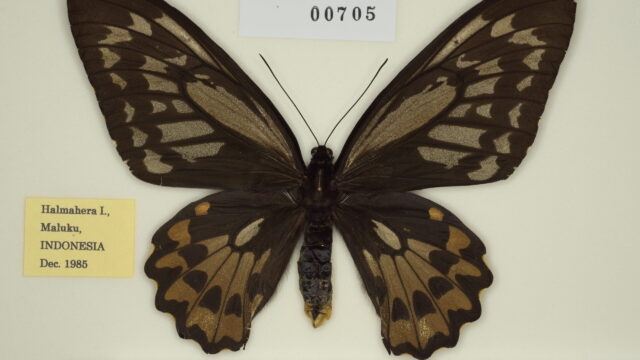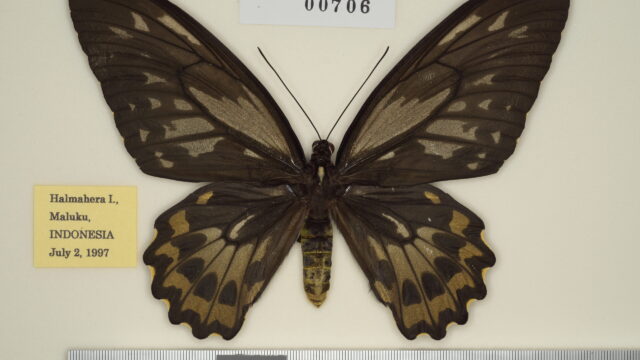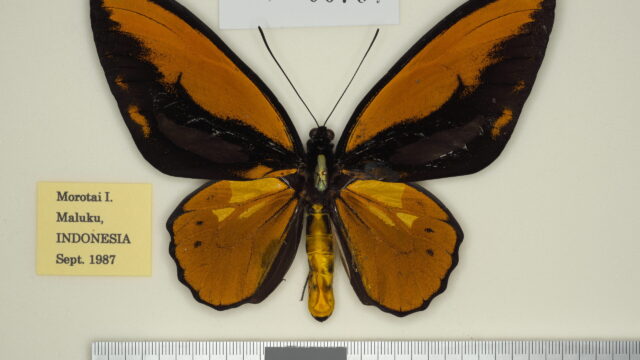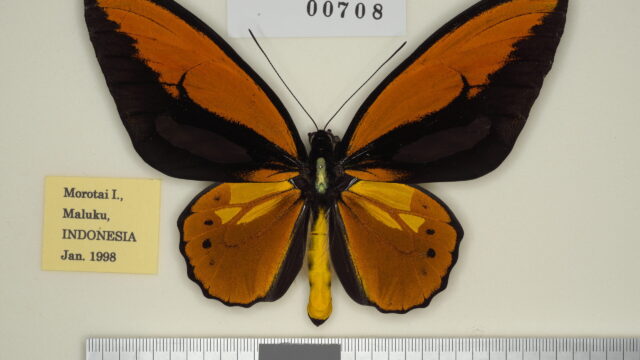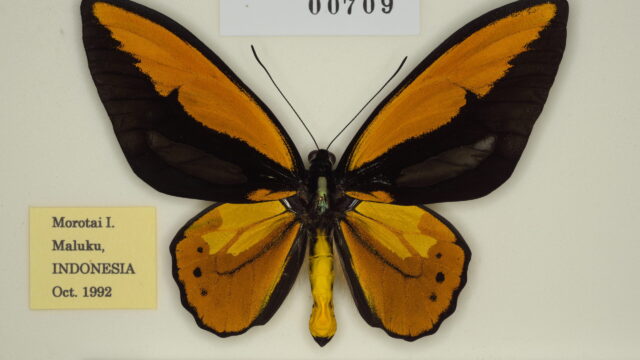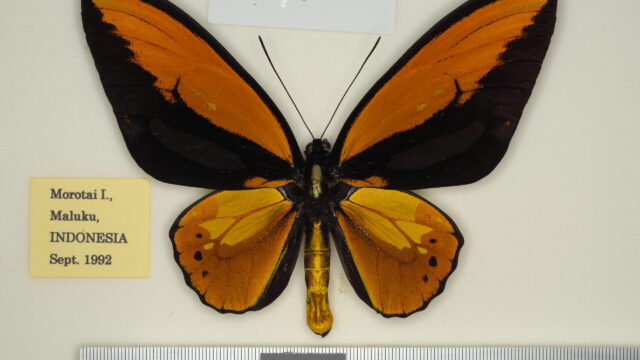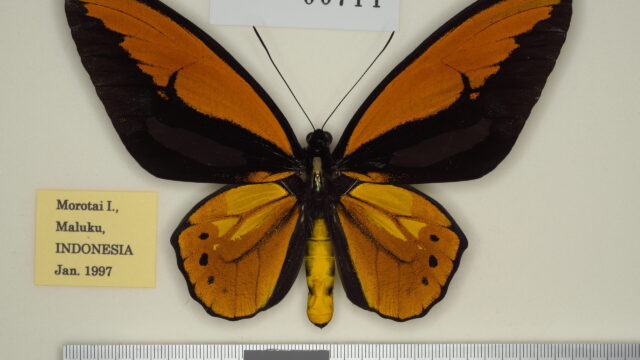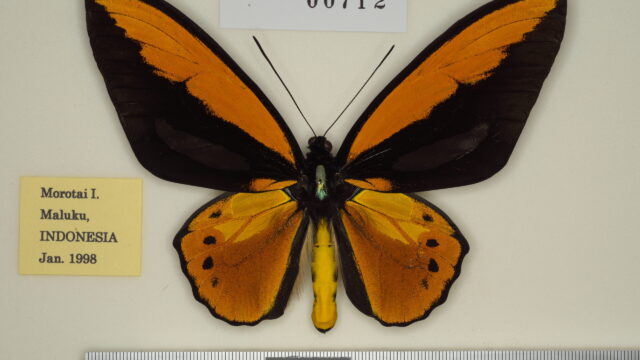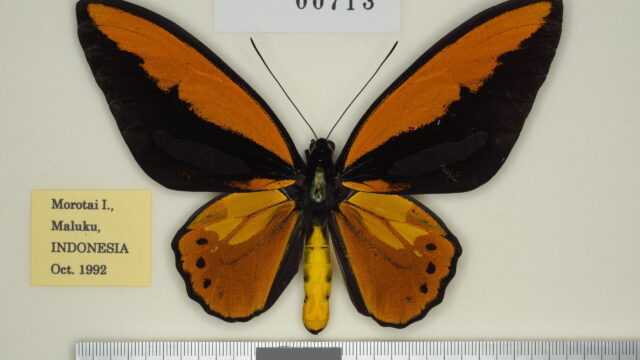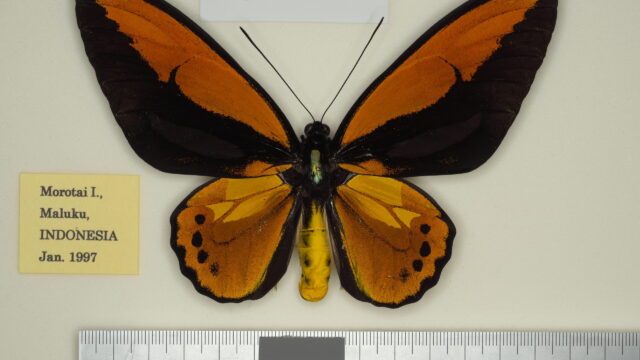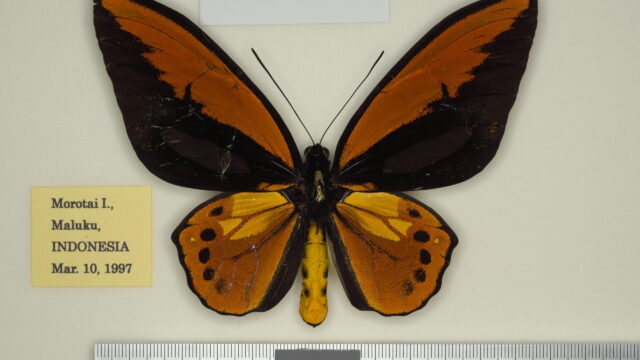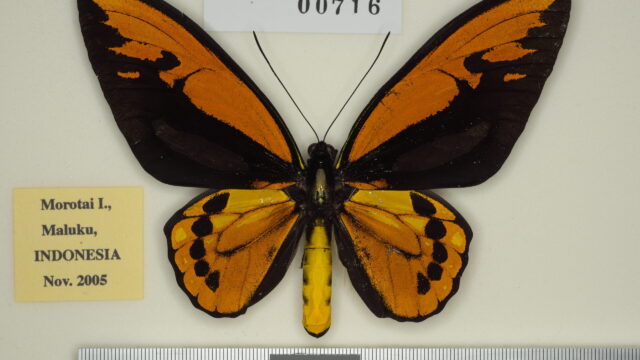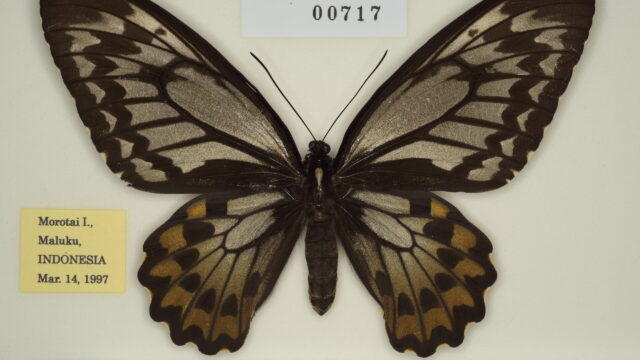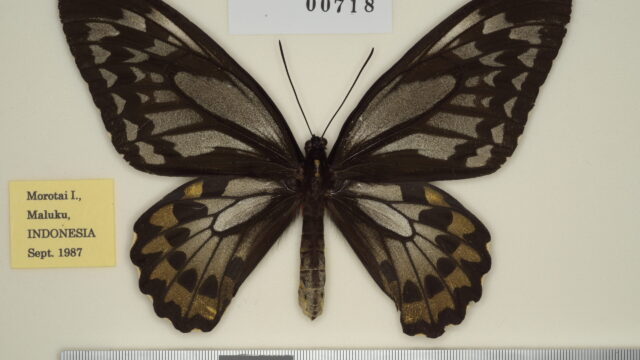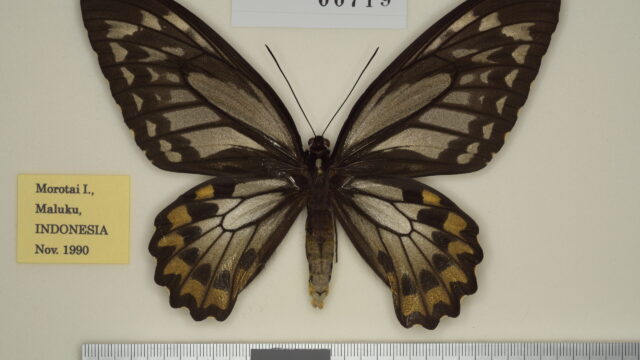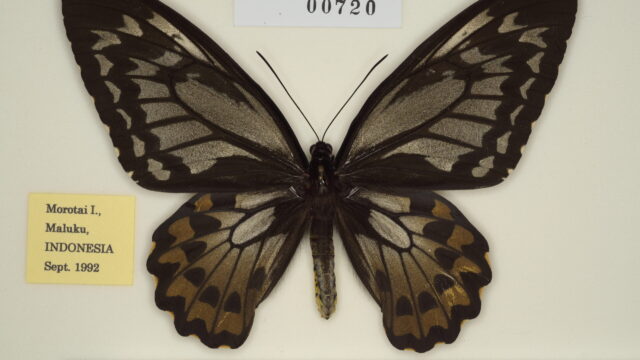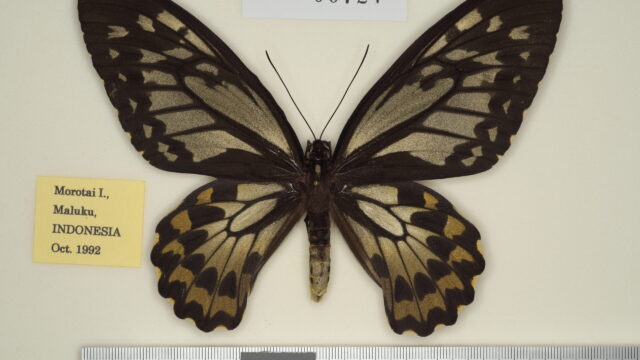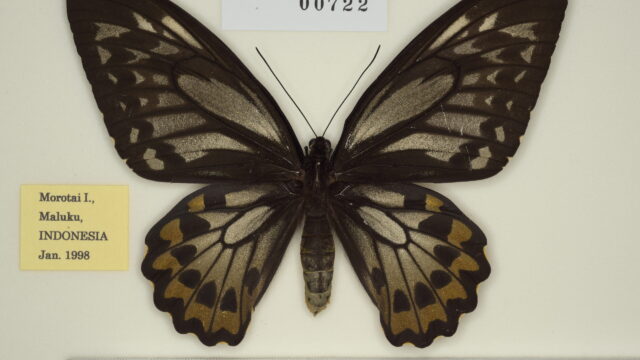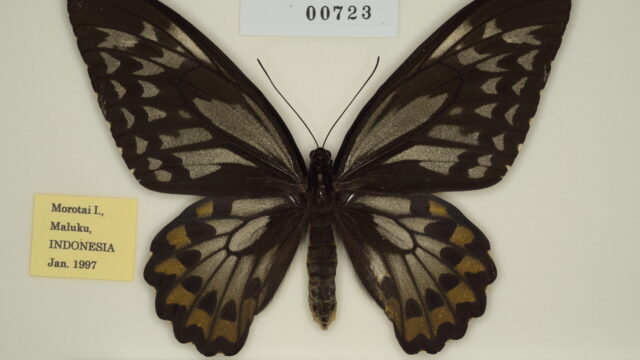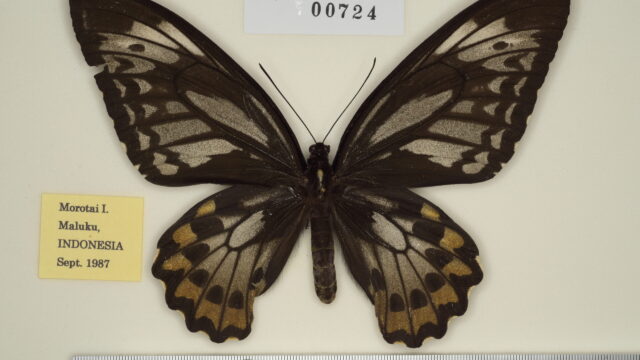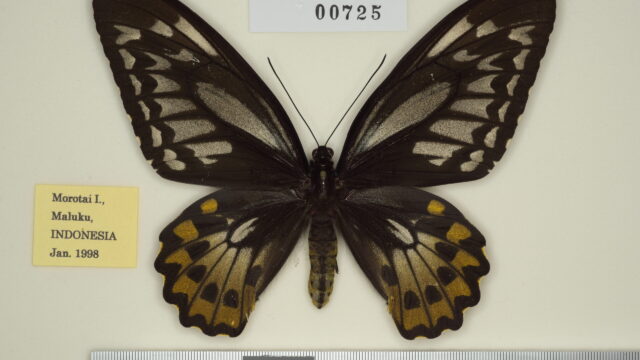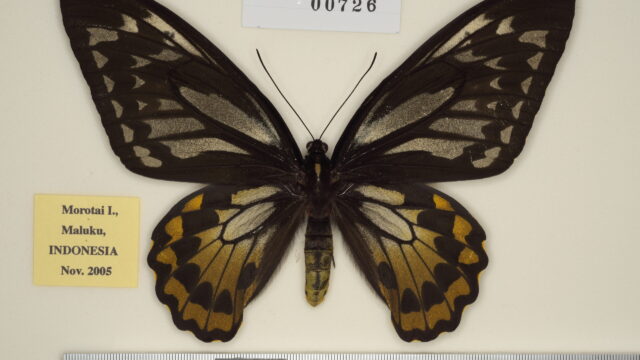- Ssp. lydius (Felder, 1865)8) [♂, ♀]
(Distribution) [Map 30]
INDONESIA [Maluku] Halmahera (=Gilolo) Is. (Galela, Tobelo, Ibu, Togola Wayoli, Susupu, Goal, Jailolo, Bicoli, Gani), Doi Is., Ternate Is., Tidore Is., Goraici Islands (Kayoa Is.).
(Episodes of discovery and original description)
Specimens of ♂ and ♀♀ collected by M. Lorquin on Halmahera Island (date of collection unknown) were illustrated by Felder in 1864 and described by him the next year as a new species of Papilio, lydius (after Lydia, the kingdom of King Croesus, where Lydius means “of the Lydian people”).
(Characteristics)
Many individual variations are known in both sexes.
(Spotted pattern)
♂: Iridescent scaling of wings is golden orange or golden reddish orange with a darker, more yellowish green sheen than nominotypical subspecies. The radial band is broader, but the anal band is somewhat smaller, on the FW. Of the semi-translucent golden spots of HW, those of the subcostal space, space 6 and the cell are larger than nominotypical subspecies, but submarginal spots are absent. The number of the black discal spots varies from 0 to 5. On the HW underside, the black frame of the cubital vein and its adjacent V2nd-V4th is thicker.
♀: It is easy to identify this subspecies from the nominotypical subspecies because of the distinctive appearance of gray spots, which occupy almost the entire of the wing, except for the dark brown marginal border and veins. On the FW, there is only a submarginal band pointing inwards. The HW also have only dark discal spots. The submarginal area is yellowish brown, but the underside of submarginal area is a clear yellowish white.
(Variation)
♂-f. berchmansii van den Bergh, 192823): [Aberrant FW pattern] Presence of an unusual submarginal band, sometimes being continuous to the anal band.
♂-f. boutoni Haugum & Low, 197911): [Aberrant FW pattern] One or several semi-translucent golden scales are present within the radial band. The occurrence rate is high in this subspecies and ssp. toeantei with individual variation in number and size.
♂-f. flammeus Niepelt, 193116): [Aberrant FW pattern/BW discoloration] Iridescent scaling of FW/HW is orange red instead of typical orange. The radial band is broad and apically pointed in spaces 7, 6 and 5. There are minute semi-translucent golden spots in space 8, 7 and 6 subapically.
♂-f. pannis Parrott & Deslisle, 198717): [Aberrant FW pattern/HW discoloration] FW iridescent scaling greatly extended. Semi-translucent golden spots prominently present and are greatly extended. HW partially greenish; the lower 4 spaces nearly filled with darker scales.
♂-f. watsoni Haugum & Low, 198112): [Aberrant HW pattern] Entirely devoid of black discal spots on HW. This distinctive form corresponds exactly to ssp. poseidon ♂-f. cronius (Felder, 1864).
♂-f. nigra van den Bergh, 192823): [Melanic form] The radial band do not reach the apex of FW. The black discal spots on the HW are larger and fused together. On the underside, blackening is more pronounced.
♂-f. nigrocincta Rousseau-Decelle, 193519): [Melanic form] HW with five black discal spots (space 3 – 7), and a 2mm band of black scales framing the median vein, broader at the base of the V2nd and V3rd.
♂-f. perroni Deslisle & Sclavo, 20085): [FW/HW discoloration- bi-colored form] The basal half of the radial band on FW, as well as discal area on HW are olive-green, while the rest of the patches is typical orange.
♂-f. laplantei Deslisle & Sclavo, 20085): [FW/HW discoloration] FW radial band red covered with almost dark black scaling, except for subapical area which seems ablaze. HW orange-brown darker discally.
♂-f. pseudocroesus Deslisle & Sclavo, 20156): [FW/HW discoloration] A yellow-orange iridescence on FW, as in ssp. c. croesus, instead of the typical orange-red color, as well as on HW.
♂-f. olivei Parrott & Deslisle, 198717): [Particular aberration] This represents an unusual combination of characters with the additional element of partly olive-green scaling rather than the typical orange. FW with f. boutoni and f. berchmansii, and HW with f. watsoni. Discal area is olive except for along veins and creating darker orange submarginal / discal spots.
♀-f. nudus Parrott & Deslisle, 198717): [Pale form] FW without dark submarginal band; so entirely filled with pale scales. Greatly reduced dark discal spots of HW are present only in spaces 5 – 7. Black scaling along the veins reduced.
♀-f. fusca Sumiyoshi, 198921): [Melanic form] Entirely darker than usual form, and dark patterns within pale markings become bigger. HW cell-spot is very minute. Submarginal area on HW underside is yellow.
♀-f. jeanne-d’arcae Deslisle, 19962): [Particular aberration] (about 1,000m altitude)On FW, there are only 5 pale spots instead of the usual 15 to 18 ones. Cell-spot is normal, but all four discal ones shorter and narrower. HW resembles those of nominotypical ssp. but darker because it is covered densely with black scales.
f. loc. toeantei Parrott & Schmid, 198418) [♂, ♀]
= morotaiensis Sumiyoshi, 198921) [♂, ♀] (Morotai Is.)
(Distribution) [Map 30]
INDONESIA [Maluku] Morotai Is. (Daeo River basin, Sabatai-baru), Loleba Kecil Is.
(Episodes of discovery and original description)
The first person to pay attention to O. croesus from Morotai Island was Haugum & Low (1979). They presented a photograph of a specimen in the collection of the British Museum (N. H.) and reported it as an aberrant. Subsequently, based on 17 specimens (6 ♂♂, 11♀♀) collected or emerged by I. Toeante between 1982 and 1983 at 800m altitude, Parrott & Schmid described it as subspecies of O. croesus in 1984. The subspecies is named after the collector, Mr. I. Toeante.
(Characteristics)
The wings of ♀are characterized by a darker ground color and smaller spots.
(Spotted pattern)
♂: Difficult to distinguish from ssp. lydius, considering the large number of specimens.
♀: Resembles ssp. lydius, but wing ground color darker, blackish brown or black with white spots, covered with black scales instead of brown scales.
(Variation)
Similar variations as ssp. lydius.
♂-f. croesuides Dufek & Schäffler, 20067): [Aberrant FW/HW pattern] The radial band greatly extended subapically on FW, and on HW, two rows of semi-translucent spots are present on discal and submarginal areas as in nominotypical ssp. croesus.
♂-f. carinae Schäffler, 200120): [Aberrant FW pattern] The radial band of FW grossly enlarged and fuses with the extra-submarginal band. In addition, above the anal band and below the cubitus a small orange mark appears.
♂-f. martini Dufek & Schäffler, 20067): [HW discoloration] Lower half of the cell and most of spaces 1b – 5 darkly covered with black scales.
♀-f. agatheae Deslisle & Sclavo, 20085): [HW discoloration] Pale area entirely of a strong yellow.
